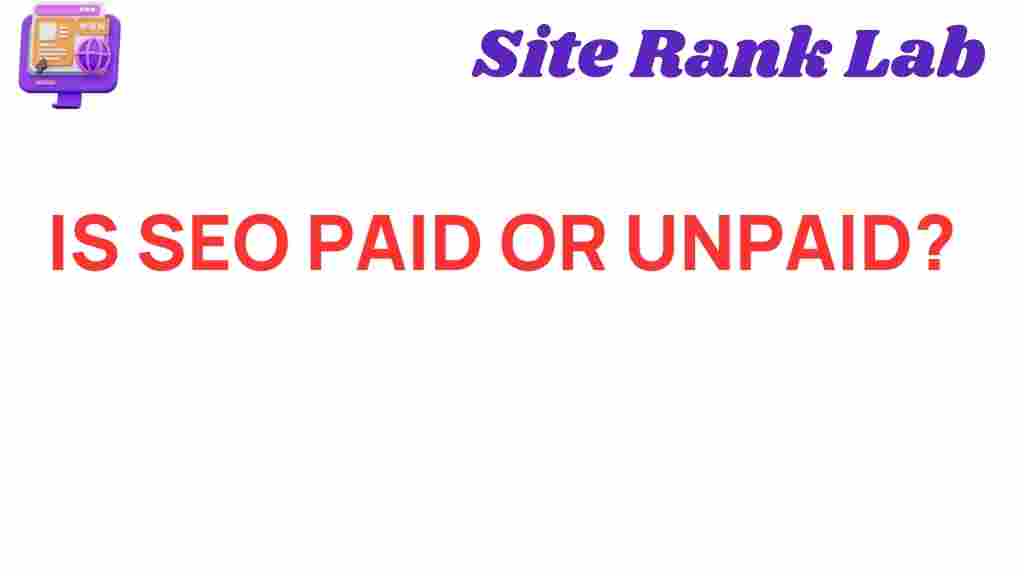In the ever-evolving world of digital marketing, businesses frequently ask a pivotal question: *Is SEO paid or unpaid?* Understanding this distinction is essential for crafting an effective marketing strategy. This article will delve into the fundamental aspects of SEO, its types, advantages, and actionable steps to implement both paid and unpaid strategies.
What Is SEO?
SEO, or Search Engine Optimization, refers to the process of enhancing a website’s visibility on search engine result pages (SERPs). It involves a mix of strategies designed to attract organic traffic, improve rankings, and ultimately drive conversions. But is SEO paid or unpaid? Let’s unravel this mystery.
Is SEO Paid or Unpaid?
The term SEO generally encompasses both paid and unpaid techniques to improve website visibility. While unpaid SEO focuses on optimizing content to rank organically, paid SEO involves investing in advertising platforms such as Google Ads to secure top spots on SERPs. Both approaches have unique benefits, but the choice largely depends on your marketing goals and budget.
The Difference Between Paid and Unpaid SEO
To better understand the two types of SEO, let’s break down their key characteristics:
- Paid SEO: Also known as Search Engine Marketing (SEM), it includes techniques like pay-per-click (PPC) advertising. Businesses pay for prominent placement in search results.
- Unpaid SEO: Focuses on organic rankings achieved through quality content, keyword optimization, and technical SEO practices.
Both strategies can be effective, but they cater to different needs. Paid SEO offers instant results, while unpaid SEO builds long-term credibility.
Why Choose Paid SEO?
Paid SEO has become a go-to strategy for businesses aiming for quick visibility. Here are some advantages:
- Immediate Results: Paid campaigns like Google Ads guarantee top rankings within hours.
- Targeted Reach: Ads can be customized based on demographics, location, and user behavior.
- Scalable Campaigns: Adjust budgets and strategies in real time to optimize ROI.
However, paid SEO requires ongoing investment and may not be sustainable for all businesses. For more tips on optimizing paid strategies, check out this comprehensive guide.
The Power of Unpaid SEO
Unpaid SEO relies on organic tactics that cost time but deliver substantial long-term benefits. Here’s why it’s a valuable approach:
- Cost-Effective: Requires minimal monetary investment compared to paid SEO.
- Credibility Boost: Organic rankings often enhance trust among users.
- Long-Term Benefits: Sustainable results through consistent content optimization and backlinking.
For detailed insights into unpaid strategies, visit our blog on content optimization.
Step-by-Step Guide to Implementing SEO
Whether you choose paid or unpaid SEO, the following steps will guide your efforts:
1. Research Your Audience
Understand your target audience’s preferences, search habits, and common queries. Use tools like Google Analytics and keyword planners to gain insights.
2. Choose Relevant Keywords
Identify keywords that align with your content and audience. Focus on long-tail keywords for unpaid SEO and high-intent keywords for paid campaigns.
3. Optimize On-Page Elements
Ensure that your website’s meta tags, headers, and content are optimized for SEO. Don’t forget to include your primary keyword, “SEO,” in key sections.
4. Build High-Quality Backlinks
For unpaid SEO, link building is crucial. Partner with reputable sites to increase your domain authority.
5. Invest in PPC Campaigns
Set up Google Ads or Bing Ads for paid SEO, targeting your chosen keywords with precision.
Common Challenges and Troubleshooting Tips
SEO is not without its challenges. Here are solutions to common issues:
1. Low Organic Traffic
Solution: Reevaluate your keywords and update your content regularly to stay relevant.
2. High Bounce Rates
Solution: Improve page load speed, enhance content readability, and use engaging CTAs.
3. Poor ROI from Paid Campaigns
Solution: Continuously monitor ad performance and adjust bids, targeting, or creatives as needed.
Conclusion: Paid or Unpaid, SEO Is Essential
Whether you choose paid or unpaid SEO depends on your business objectives and budget. Paid SEO delivers rapid results, making it ideal for short-term goals. Unpaid SEO, on the other hand, builds trust and sustains long-term growth.
By integrating both strategies, you can maximize your digital marketing efforts and achieve unparalleled visibility. Begin your SEO journey today and watch your online presence thrive!
This article is in the category SEO and created by SiteRankLab Team
